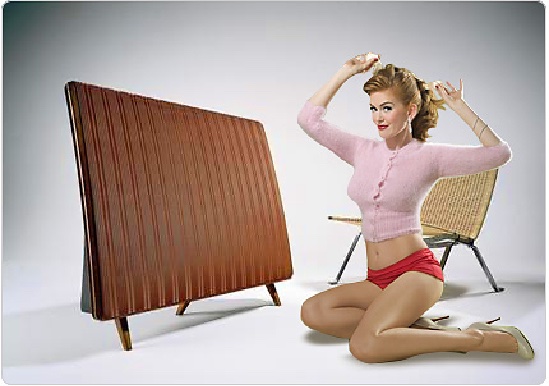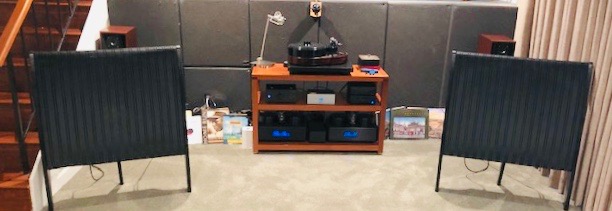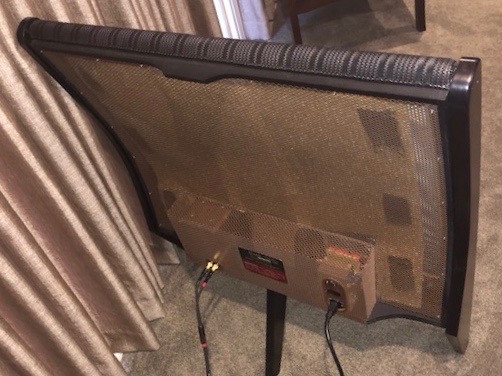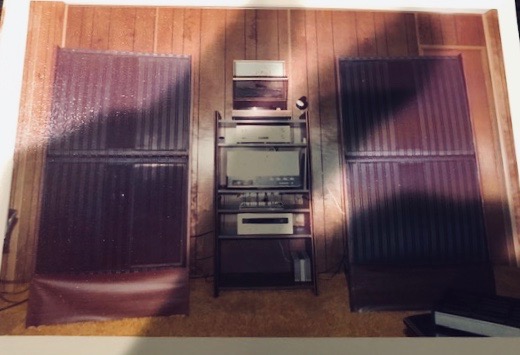
This French advertising photo is one of my favorite pictures of the original QUAD ESL 57s. Why review a speaker that was designed in the mid-1950s, released to the market in 1957, and discontinued from production in 1984? There are three reasons that come to mind. First is that there were so many sold worldwide that they are still readily available today on the used market. Second, there are people around the world who rebuild them. For me though, the third reason is the only real reason, and that is because of how they allow listeners to enjoy and be emotionally invested in recorded music. It is shocking how many speaker designers, reviewers, and music lovers own a pair.
In my recent column, “The On-Going Story Of The Original QUAD Electrostatic Loudspeaker,” I shared my personal history of owning a pair of QUADs in the mid-seventies. I have owned a single-pair of QUADs and also a stacked pair. I have also heard several different restorations and reimaginings of the ESLs.
At the Capital AudioFest in November, I discovered the ElectroStatic Solutions version of the original QUAD ESLs. These were in Robin Wyatt’s room, and I reviewed this room here. I couldn’t live without these QUADs, so now I own them.
Setting Up the QUAD ESLs
Setup is very critical for nearly all speakers, but setting up the QUAD ESLs is different. For one thing, their set up will be counter-intuitive if you are used to setting up conventional speakers.
First of all, the closer you place them to the rear wall the less bass they will have. They need enough room to develop a bass wave behind them and in front of them. This will probably be at least a few feet into the room. I got really good results placing them five feet from the wall behind them. Second, it doesn’t hurt the sound for them to be just an inch or two from the sidewalls.
They also sound best in a “near field” setup. The two tweeter panels and the listener should form an equilateral triangle. In my room, they are five feet out from the wall behind the speakers and three inches from the sidewalls. The centers of the tweeter panels are eight feet, three inches apart and my ears are eight feet, three inches from each tweeter panel.
In this setup, the bass goes down to at least 40 HZ. You may not think that is very low, but the quality, power, and scale of the bass is significantly more like real music than I’ve heard from any speaker that goes down into the 20 HZ region. They are as fast as lightning and still have the best tonality that I have heard in my room. The soundstage they produce is also the most believable and the most layered that I have heard.

Description
I asked Kent McCollum of ElectroStatic Solutions to explain what he does to make their QUAD ESL 57s so special. His reply was quite long, but it’s worth the read:
Hi Jack,
QUAD produced approximately 55,000 of the original electrostatic from 1957 to 1985. It was the world’s first full-range electrostatic speaker. Overall the design is quite reliable contrary to what has been claimed. About half of the speakers I service are still working. The major problem with reliability was people failing to read their Owner’s Manual which made clear the speaker was limited to a maximum of 33VAC. After that, you will arc panels. This problem has been solved since we use a protection circuit that limits the voltage to a maximum of 33VAC. I have never seen an arced tweeter panel with the protection board in place no matter the output of the amp.
The protection circuit is placed in parallel with the audio signal and does nothing until the voltage threshold is reached then it engages. I hear no sonic impact. Previous attempts to protect the speaker used some sort of protection scheme in series with the signal. This did degrade performance.
While the QUADs are a robust design they do degrade over the decades, rather dramatically in fact. My personal pair was produced in 1959. It has never been serviced and it still works nicely but far from original specification.
The speakers degrade in three ways:
- The conductive coating degrades reducing efficiency typically 2-3dB. This takes decades to have any impact.
- The carbon comp resistors in the filter network go high in value. The network carefully balances the output of the bass panels relative to the tweeter panel. When the resistors go high it reduces the output of the bass panels upsetting the balance between the panels. Loss of bass leaned out midrange, rather hot on the top is the sonic result.
- The worst way they degrade is the film used in the bass panels. Quad only used Mylar film in the tweeter panel. I imagine Mylar was quite expensive in the 50s-60s.
The film that was used in the bass panels was polyolefin. Polyolefin has a lot of plasticizers in the film Mylar does not. Over time the plasticizers leech out of the film causing it to become brittle and tight. This raises the panel resonance. I have seen it raise as high as an octave. This kills bass response the reason some say they have no bass capability. They don’t in this condition!
Even if one managed to find a NOS Quad ESL, never used, it would no longer meet spec. There is no way to stop the leaching of plasticizers over time whether the speaker is in use or not.
A modern rebuild solves two of the three problems. Since we use original tooling, techniques, and processes as employed by the factory we will still have the problem of the conductive coating. but this is relatively minor and takes decades to have any impact.
I use 3 micron Mylar in all the panels. This is much thinner than what the factory used. Electrostatic forces are weak and this dramatic reduction in moving mass has a dramatic impact on performance especially in the bass.
The stock bass panels run out of steam around 95dB or so depending on the bass content. You can clearly hear this loss of control. With the thinner film, the bass panel maintains excellent and the speakers working properly can easily exceed 100dB levels.
The filter network is rebuilt. Carbon comp resistors were used originally and sound excellent especially in the midrange. But I wanted to find something that would remain stable over time. We spent a lot of money and time listening to resistors and caps for this application. We produced a lot of custom resistors from the likes of Vishay, Caddock, Texas Components bulk foil types. NOS Allen Bradley carbon comps, just about anything we could find. Same for the capacitors. We had RelCap produce several different film and foil types. The factory used ceramic disc capacitors.
All the caps and resistors sounded good. In the end, I felt along with my listening panel that the custom Vishay sounded virtually identical in the mids versus the stock resistors and performed much better at the extremes. We also use metalized polypropylene types for the caps. In addition to new components in the filter network, I install Cardas binding posts and the protection circuit.
The power supply uses a new EHT board that I produce. It is the same circuit as the factory and originally I used similar diodes and caps, ceramic disc. Stax always employed film caps in their power supplies so I decided to try this with the Quad supply. The new EHT board uses WIMA MKP-10 film caps, high-speed soft recovery diodes, and carbon film resistors.
The frames and front screens are cleaned, repaired and repainted.
I have changed nothing about the basic design. All I am doing is using modern materials. The overall tonality and everything that is great about the QUAD remains the same. That about covers it. If you have any questions let me know.
Kent

Weaknesses
Everyone has heard that the QUAD ESL 57s are great speakers but with serious weaknesses. So, let’s address their weaknesses. The biggest weakness of the Quad 57s that I remember is that they didn’t play loud enough for rock music or big band music. The only way I found to overcome this weakness was to stack my QUADs. The problem with this is price and space. They have to be at least six feet high and about 3 feet wide and have a base around eighteen inches deep.
Five years ago I had Wayne Picquet’s restored QUADs in the house, and I thought that they were an improvement in this area, but the improvement wasn’t quite enough. The great news is that the ElectrosticSoutions QUADs have solved this problem. With their protection circuit, you can now use an amp with enough power to drive them.
One other weakness I remember is their lack of power in the bass. These QUADs also solve this problem. My guess is that the thickness and tension of the mylar is the solution. Of course, the right amps are also a key to getting power in the bass.
The one weakness that has not been solved is that the treble beams in a way that causes a very small sweet spot. The speakers sound nice no matter where I sat, but it was only in the small sweet spot that they were simply magical.
Strengths
There are reasons that a speaker created in the mid-fifties is still so highly thought of. My overwhelming memory of listening to QUADs was how well they reproduce the human voice. I can say even now that I still have not heard another speaker that reproduces the human voice in such a natural and realistic way as the original QUADs did. This is especially obvious when listening to several people singing at once, a choral group, an ensemble or even backup singers.
Reviewers always talk about how important it is to reduce the level of background noise in a system. There are no speakers that are quieter than the QUAD ESL 57s nor none with such low distortion numbers. Over the last forty years, I have heard speakers where the voice has more energy, where the voice is more prominent, but they were never close to the QUADs in sounding so much like a human voice.

The second positive memory I have of the original QUADs is the way they presented the music. I recently texted Drew, one of our reviewers, that the sound of these QUAD ESLs was as if there was no noise at all and then all of a sudden there was a room full of music that just appeared behind the speakers.
Planar vs. Dynamic
You shouldn’t expect a planar to perform like a dynamic speaker in the way they launch the music into the room. You’re not going to experience music with them in the same way you would with a dynamic speaker that has a powerful magnet that can really pump sound out. For example, the bass of the Klipsch corner horns, the Altec A7, the Burwell & Sons Homage speakers, the Linn Audio Loudspeakers Athenaeum, and the QUAd ESLs all have about the same bass range. They all move a lot of air because of the large area of the bass drivers or, in the case of the QUADs, the bass panels.
The dynamic speakers produce this bass like a piston that pumps the music out into the room. The QUAD ESLs have a very palpable bass that comes out in a wave that is launched both behind and in front of the speakers. None of these speakers go quite as low as the Teresonic Ingeniums or nearly as low as the Audio Note Es, or the DeVore Orangutans, but the QUAD ESL lets your body physically feel the bass more than the Teresonic or the Audio Note speakers do.
I also remember the QUAD ESLs having the clearest window on a performance of any speaker that I had heard. This would certainly have still been true for me as little as 8 years ago, but both the Teresonic Ingenium XRs and the DeVore Orangutans are ever so slightly more transparent, more immediate and more alive sounding. The Teresonics are significantly faster sounding. Part of the reason for this is that all three speakers offer a different perspective. The Teresonics are much more like sitting in the very front row of a performance, the Orangutans more like a few rows behind the prospective of the Teresonics, and the QUADs are more like midway back, but not too distant.
Two Amps
This article is an introduction to the first of two reviews of the ElectroStatic Solutions QUAD ESL 57s. In the first review, I will be using the Butler Audio Monad mono-blocks, the amps I heard the QUAD ESLs with at Capital AudioFest. In the second review, the QUAD ESLs will be driven by my PureAudio ONE Integrated Amp. So stay tuned for some real fun!


I bought my two ESLs in1958 and they are still going strong, having been revived by Quads in Peterborough, They are augmented by an AudioPro subwoofer which nicely fills in down to about 20 cps. So the 32ft organ pipes come through brilliantly. Alas I only have a smallish room so this way of expanding the bass makes up for not being able to get them away from the walls. I wouldn’t be without them! They are effortless to listen to.
Back in the 1960s I first noticed QUAD speakers. At the time, BASS was what I wanted and I spent several years chasing it. So at one point I listened to a pair of QUADs. I was underimpressed. They sounded “nice” but not special. And so for about 20 years I bought various speakers. I was mostly happy but never really totally fulfilled. And then a friend told me about his QUADs and offered to sell them to me for AU$150. I bought them and have never looked back. For just listening to real music, they can’t be beaten. For several years I used them with a small Denon amplifier but I always knew they were not quite balanced. So a couple of years ago I had them rebuilt by John Hall in Melbourne, Australia. He rebuilt one tweeter panel, replaced the EHT power supplies and some other components and added a protection circuit. He set them up in his garage for me to listen to. He powered them with some early QUAD valve amps and the result was amazing. The stereo image was so well defined and the orchestra might have been in the room. They are playing as I type this. I can listen to them forever and never become tired of them.
For 4 weeks now I own a pair of S/N 22xxx (too comfortable in the sofa..). Very good priced and serviced some years ago (believable). Bought them without ever having a listen to these, how can I say, Citroen DS in speakers, before. I have a QUAD pre/power combo, but with JBL Lancer 99s (grandfather).
All the praise i read of, detail, stage, transparency without coloration, what have you, the two are living perfectly up to it. I am amazed indeed.
There’s one thing i can’t understand. I am a drummer with some 50+ bands played,600something gigs under my belt. Not heavy or metal, but surely smashing loud enough, as my mates surely will agree.
Now: what is the point about the esl57 not being loud, rock-eable enough? I really don’ t get it. I have my 34/303 combo in a 20sqm room and have plenty bass, midrange bursting with information and peaks up to 100 dB. I don’t miss subs, ionic tweeters, stacking or such at all. And i do have a treble dip due to my snare drum btw. If i want to sling the wrecking ball I either turn to my JBL 2226 equipped “drumbox” in the practice room or plug The Paul into a well hung VoxAC30 (see Daniel Lanois “workout”, youtoob..) and give me a blow. But for such purpose i surely won’t make use of a speaker system based on a metallized mylar film.
All in good humour, understand, and thank you a lot for useful information. I just had to get rid of this. : )
David, Glarus
I once owned two pairs of ESL57’s in the mid nineties, had them arranged horizontally across a raised area of a large open-concept, living-dining area. I drove them with two QUAD 303 amplifiers and while not restored in any way, they were loud enough for my music tastes and communal living. They excelled on the reproduction of the human voice, small chamber ensembles and acoustic instruments. I never felt the need for increased volume their only fault was being too revealing on poorly produced recordings . Both pairs were well-used when I bought them and I could hear output disparities in the bass panels. At that time, QUAD UK was going through a transition, QUAD dealers were disappearing and it appeared no one with the talent or resources to properly rebuild them could be found. I sold them due to a career relocation and downsize of residence. I have come across ESL57s with damaged HF units, the owners always overdriving them or some listed for sale at high prices with claims of “original panels – work perfectly” and anyone who understands these speakers which went out of production in 1983, know 40 year old panels have passed their best-before-date. Many don’t understand what these speakers were capable of reproducing . Even with my listening space now at a premium I can’t comprehend why anyone pays $4K + for shoebox mini monitors on stands.
I first heard the ESL 57 at a hi-fi show in the 70s, when I was in my teens, and I can remember my astonishment as if it were yesterday. I bought a used pair in 1979, when I was at university (and was lucky enough to have a huge room to accommodate them). When real life intruded and I moved to a tiny bedsit in London my ESLs had to go. Like many a first love I’ve been looking for that sound ever since, and never truly found it. I had Quad 989s for a few years, which were excellent, but not “magical”. I’ve heard just about every high end speaker, over the years, but there’s a unique “something” about the ESL 57. The best way to describe the experience is “you know it when you hear it”.
In my current, small, listening room I’m very happy with my Falcon LS3/5a Gold Badge. They too have magic. But if I ever move house and have the space, I’ll almost certainly go back to my first love and call it a day. Talk about The Circle of Life!